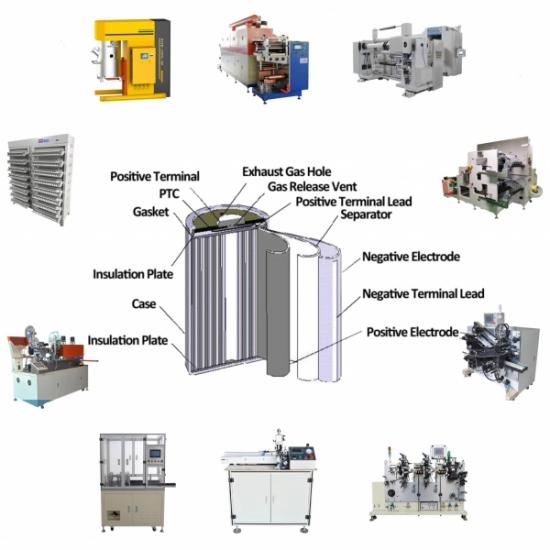Lith Corporation, founded in 1998 by a group of material science doctor from Tsinghua University, has now become the leading manufacturer of battery lab&production equipment. Lith Corporation have production factories in shenzhen and xiamen of China.This allows for the possibility of providing high quality and low-cost precision machines for lab&production equipment,including: roller press, film coater,mixer, high-temperature furnace, glove box,and complete set of equipment for research of rechargeable battery materials. Simple to operate, low cost and commitment to our customers is our priority.
What is Prismatic Cell Pack Equipment?
Prismatic Cell Pack Equipment refers to the specialized machinery and systems used to assemble prismatic lithiumion battery cells into modules, and then integrate those modules into complete battery packs. These systems are essential for manufacturing highperformance, highreliability battery systems used across various industries, including:
Electric Vehicles (EVs) – Cars, buses, trucks
Energy Storage Systems (ESS) – Gridscale storage, renewable energy integration
Industrial Applications – Forklifts, AGVs (autonomous guided vehicles), mining equipment
Transportation – Electric trains, ships, boats
Unlike cylindrical or pouchtype cells, prismatic cells are rigid, rectangularshaped batteries typically housed in aluminum or steel casings, which makes them ideal for structured, modular pack design and integration.
The goal of prismatic cell pack equipment is to ensure consistent, highquality assembly with precise electrical and mechanical connections while meeting highvolume production requirements and stringent safety standards.
Main Types of Prismatic Cell Pack Equipment
A full battery pack production line consists of multiple interconnected machines and systems. Here are the key types of equipment involved:
1. Cell Inspection and Sorting Equipment
Used to test incoming prismatic cells for:
Voltage
Internal resistance
Capacity
Cells are sorted based on performance metrics to ensure balanced module behavior.
Ensures consistency and extends overall pack life.
May include automated conveyors and data logging systems.
2. Module Assembly Equipment
Includes workstations or fully automated systems for stacking and arranging cells into predefined module configurations.
Often includes:
Fixtures for alignment
Robotic arms for handling
Sensors for placement verification
Additional components like insulation layers, cooling plates, and brackets may be added during this stage.
3. Busbar Welding Machines
Connects individual cells electrically via copper or aluminum busbars.
Common welding technologies:
Laser welding – High precision, minimal heat impact
Ultrasonic welding – Suitable for thin metals and dissimilar materials
Equipped with vision systems for weld quality inspection and realtime feedback.
Critical for ensuring lowresistance, durable connections.
4. Housing Installation Systems
Installs protective housings or trays around assembled cell stacks.
Includes:
Dispensing units for thermal interface materials (TIM)
Clamping and fastening tools
Sealing systems (especially for liquidcooled designs)
Some systems also integrate cooling plates at this stage.
5. Leak and Pressure Testing Equipment
For battery modules with liquid cooling, pressure or leak testing is performed.
Techniques include:
Air pressure decay test
Helium mass spectrometry leak detection
Ensures no coolant leakage during operation.
Typically automated with digital result logging.
6. Electrical and Functional Test Benches
Each module is tested for:
Voltage balance
Insulation resistance
Communication with Battery Management System (BMS)
Fully integrated test benches can simulate load conditions and verify functional performance.
Data from these tests is often stored digitally for traceability and quality control.
7. Battery Pack Integration Stations
Combines multiple modules inside a final battery pack enclosure.
Integrates:
The Battery Management System (BMS)
Wiring harnesses and connectors
Thermal management systems
Safety interlocks and structural reinforcements
Can range from manual stations to fully robotic lines depending on automation level.
8. Final Pack Testing Systems
Comprehensive testing of the completed battery pack includes:
Charge/discharge cycles
Thermal performance validation
Communication checks with vehicle or system controllers
Ensures compliance with industry standards such as:
UN38.3 (transport safety)
IEC 62660 (automotive battery testing)
ISO 26262 (functional safety)
9. Labeling and Packaging Equipment
After passing all quality checks, the battery pack is labeled with:
Serial number
QR/barcode
Production date and batch info
Then it is documented and packed securely for shipment.
Automated labeling systems and conveyorbased packaging lines are commonly used.
Cylindrical cell production line
Levels of Automation in Prismatic Cell Pack Equipment
Depending on production volume, complexity, and investment capacity, prismatic cell pack equipment can be implemented at different levels of automation:
1. Manual Equipment
Best suited for R&D, prototyping, or smallscale production.
Requires significant human involvement.
Low cost but limited scalability and consistency.
2. SemiAutomatic Equipment
Combines automated functions (e.g., welding, testing) with manual handling.
Offers flexibility and costefficiency.
Ideal for midscale production or custom applications.
3. Fully Automatic Equipment
Highspeed, robotdriven systems with AI vision, realtime data tracking, and MES integration.
Designed for highvolume output.
Found in large EV and ESS manufacturing plants.
High initial investment but offers excellent repeatability and traceability.
Design Considerations When Selecting Prismatic Cell Pack Equipment
When choosing or designing your prismatic cell pack equipment, consider the following factors:
Cell Compatibility: Ensure equipment supports your specific cell dimensions and type.
Production Output Goals: Match the throughput to your daily or hourly target.
Thermal Management Requirements: Decide whether your design uses aircooling or liquidcooling.
Integration with BMS: Seamless communication between modules and the BMS is crucial.
Safety Features: Include fire suppression, emergency stops, and explosionproof enclosures where necessary.
Traceability & Digitalization: Implement digital tracking systems for process optimization and quality assurance.
Benefits of Using Prismatic Cell Pack Equipment
Enables scalable and repeatable battery production
Offers excellent structural stability and thermal management
Supports both lowvolume and highvolume production
Reduces failure risks compared to pouchtype cells
Facilitates automation and realtime monitoring
Improves product consistency and reduces labor costs
Leading Companies Providing Prismatic Cell Pack Equipment
Some top companies offering turnkey solutions or key components for prismatic cell pack equipment include:
KUKA Systems – Advanced robotic automation for battery assembly
B&R Industrial Automation (ABB) – Integrated automation platforms
Gree EnergyTech – Complete module and pack line solutions
Hanson Robotics – Smart battery manufacturing systems
Hyundai WIA – Specialized automotive battery equipment
EnerSys – Experts in energy storage system integration
Tesla (inhouse developed systems) – Custombuilt lines for Gigafactories
Need Help Choosing or Setting Up Your Prismatic Cell Pack Equipment?
If you're looking to select, design, or optimize your prismatic cell pack equipment, I can help you with:
Equipment selection and automation strategy
Process flow and layout planning
Factory space optimization
Supplier recommendations and cost estimation
Customization based on your specific application and production goals
All you need to do is provide the following information:
Cell dimensions and chemistry
Desired production volume per day
Level of automation needed (manual/semiauto/fullauto)
Target application (EV, ESS, industrial, etc.)



 Online service
Online service
